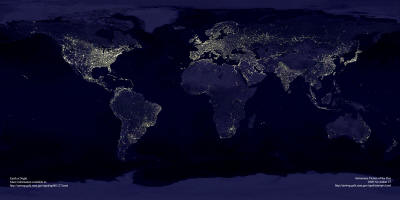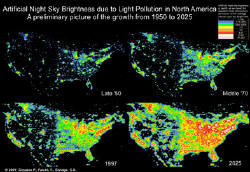|
January 8,
2003
Founded in 1983, National
Park Trust (NPT) is the only land conservancy uniquely dedicated to preserving America's national system of parks,
wildlife refuges, and
historic monuments.
NPT publishes the Parkland News to help you and other members of the public to
stay informed about challenges and developments facing our parks and
our environment.
To help us preserve America's treasures, please click here to
checkout our
web site
Subscribe
to
Parkland News
|
Promoting and
Protecting Dark Night Skies in Our National Parks
|
CHAD MOORE - US
National Park Service, Pinnacles National Monument, 5000
Hwy 146, Paicines, CA 95043
F.OWEN HOFFMAN - Crater Lake Institute, SENES Oak
Ridge, Inc., Center for Risk Analysis, 102 Donner Dr.,
Oak Ridge, TN 37830
DAVID FIELDS - Tamke-Allan Observatory, Roane
State Community College, 276 Patton Ln., Rockwood, TN
37854, and
RON MASTROGIUSEPPE -
President, Crater Lake Institute, P.O.
Box 2425, Pullman, WA 99165-2425 |
|
|
Our
National Parks contain the most splendid parts of
this country's landscape and history. Many of these
protected resources were well recognized at the time
the parks were created, for example the geysers of
Yellowstone or the giant trees of Sequoia. But as
the interest of the public changes and the natural
landscape is altered, what is valued as a park
resource also changes. Today, the National Park
Service is adapting its management toward the
protection of dark night skies.
The night sky is a timeless and boundless resource,
possessing value as a cultural, scenic, natural and
scientific resource. It is germane to no particular
nation, religion, or belief, but is universally
important. The impression of a dark and starry sky
has evoked countless myth, art, literature, and
inspiration. It has been rightly called "The
Ultimate Cultural Resource." But the ubiquity and
scale of this resource has led to the common human
folly of taking it for granted. Now we stand on the
verge of losing the pristine night sky in the
conterminous United States.

Earth at Night (Click photo for a larger
view)
Man's imprint on the planet is dramatically
visualized with satellite images of the Earth at
night [Sullivan]. The areal extent of light
pollution has been modeled by astronomers, and the
result shows the progressive loss of the dark sky,
even in once remote areas [Cinzano et.al.]. National
Parks harbor many of these last portals to a dark
night sky. The role the NPS can play has been
underscored by non-profit organizations such as the
George Wright Society and the International Dark-sky
Association. In response, the park service initiated
a small but aggressive program to measure light
pollution levels at numerous parks throughout the
country.
 The proliferation of poor quality outdoor lighting
is the principle threat to the nighttime scene.
Urban sky glow can travel over 200 miles, affecting
remote wilderness and parks. Moderate amounts of
light pollution can cut the number of visible stars
in half or more, while skies within a few miles of
cities will be decimated. Not only can one's
backcountry camping experience be tainted, but
nocturnal wildlife suffers ill effects to varying
degrees. The problem is far from intractable,
however, with modern lighting designs that produce
very little scattered light increasingly available.
High quality lighting improves security, reduces
energy consumption, and is often less expensive.
Some communities have chosen to upgrade their
lights, instantly improving the night sky and
reaping these other benefits. The proliferation of poor quality outdoor lighting
is the principle threat to the nighttime scene.
Urban sky glow can travel over 200 miles, affecting
remote wilderness and parks. Moderate amounts of
light pollution can cut the number of visible stars
in half or more, while skies within a few miles of
cities will be decimated. Not only can one's
backcountry camping experience be tainted, but
nocturnal wildlife suffers ill effects to varying
degrees. The problem is far from intractable,
however, with modern lighting designs that produce
very little scattered light increasingly available.
High quality lighting improves security, reduces
energy consumption, and is often less expensive.
Some communities have chosen to upgrade their
lights, instantly improving the night sky and
reaping these other benefits.
As the public loses the experience of a dark sky at
their homes, they are increasingly seeking it out in
their national parks. There is an untapped
opportunity to interpret the night sky at parks,
provide the public with a tangible perspective on
the connection between people and the environment,
and to engender environmental leadership on this
issue.
Amateur astronomers and skygazers can play a
significant role as park volunteers. Chaco Culture
National Historical Park in New Mexico has done this
beautifully. A small army of volunteers give
frequent nighttime programs to park visitors,
providing views through numerous telescopes and
linking the sky above to the ancient American
culture and stone ruins that are the park's
namesake.
In Yosemite, visiting San Francisco Sidewalk
Astronomers encourage public viewings through large
and moderate sized telescopes set up during the
evening hours at major viewpoints. During 2002, the
Crater Lake Institute recruited former NPS
naturalists with an interest in astronomy to bring
the joy and inspiration of the night sky to Crater
Lake National Park visitors.
At the rim of the famous caldera, visitors were treated to
informal star walks, all night star gazing, and
discovered the "other half" of the park. Other
parks, like the Grand Canyon and Bryce Canyon have
become destinations for special "star parties" where
amateur astronomers from all over the country gather
to compare views of the heavens through binoculars
and portable telescopes.
The task of promoting the value of dark skies above
National Parks has only just begun. Activities
focused on public enjoyment of dark skies are likely
to spread throughout the entire National Park
System. Special programs can be established on an
ongoing basis without a major impact to limited park
budgets by forming partnerships with local and
national groups engaged in the study and enjoyment
of the night sky. Amateur and professional
astronomers can be purposefully invited to visit the
parks with the express objective of sharing
knowledge and equipment with a curious public.
A positive dark sky experience in our National
Parks, enhanced through interaction with
knowledgeable naturalists of the night, will lead to
increasing public awareness of the joy of gazing
upward and a burning desire to protect and reclaim
starry nights beyond park boundaries. |
|
|
Related Web Links
1. Chadwick A. Moore.
Visual Estimations of
Night Sky Brightness
from George Wright
Society Forum:
http://www.georgewright.org/184moore.pdf
2. International
Dark-sky Association,
a source of general
information:
http://www.darksky.org/
3. Crater Lake
Institute, supporting
Dark Skies at Crater
Lake National Park:
https://www.roanestate.edu/obs/CraterLakeInstitute.html
4. Tamke-Allen
Observatory,
presenting education
as a process of
scientific inquiry and
observation:
http://www.roanestate.edu/obs
5. Links to additional
park-related Dark-Sky
resources:
http://www.roanestate.edu/obs/Dark%20Skies%20Materials.htm
IMPORTANT
For copyright
information on the
Cinzano et al image,
see:
http://www.inquinamentoluminoso.it/worldatlas/pages/copyright.html
The Earth at
Night image
credited to Woodruff
T. Sullivan. |
|
Copyright
2003 National Park Trust
http://www.parktrust.org
|
|



